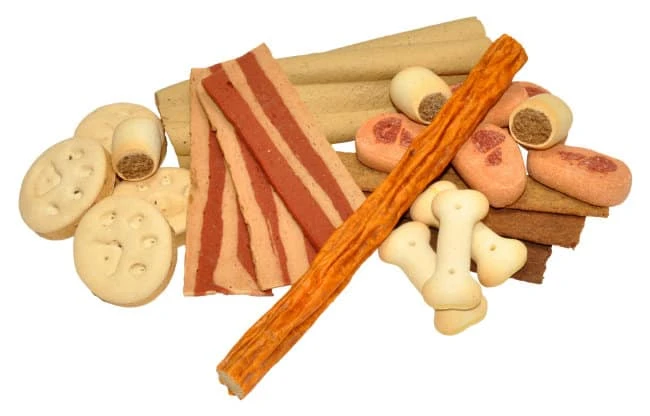How To Find Healthy Dog Treats For Training

Dog owners give their pets treats to express their love, but healthy dog treats, also play a critical part in dog training and rewarding good behavior. Treats are a valuable way to reinforce your satisfaction when your dog obeys. Like humans, dogs repeat the behaviors that bring the greatest rewards. Although they learn to appreciate petting, praise, and play, treats appeal to their keen sense of smell and provide an exciting and tangible incentive to obey. Training with treats is especially effective with younger dogs, when they’re learning new commands, such as “sit” or “stay.”
When you use treats for positive reinforcement, you’ll increase your dog’s enjoyment of the training and his desire to partake in the training process. Treats followed by an occasional pat on the head also strengthens the bond you have with your furry friend. Once you decide to use treats for training, you must learn what kind of treats to use and the best places to find them.
Make Your Own
Busy pet owners might cringe at the thought of making their own treats. But making your own can save money and safeguard your pet against the harmful ingredients found in many commercial treats. The best part of making your own treats is that you can use a lot of the dog-friendly ingredients you have on hand.
Basic dog biscuits, blueberry dog-nuts, and flaxseed bones are just a few treats you can make from scratch. But there are many other ways to make homemade dog treats without a using recipe. Raw vegetables, yogurt p opsicles , peanut butter stuffed apples, and ice cube surprise are treats you can make on the go.
Fresh vegetables won’t have high quantities of fat, preservatives and sugar as store-bought snacks. Carrots, broccoli, and green bean are crunchy and have very few calories. Fruits are good too – if your dog is open to trying new foods. Berries, watermelon, and bananas are wonderful both fresh or frozen. Don’t feed your dog raisins, grapes, onion or chocolate as these can be toxic for them.
When using raw veggies by themselves or including them in baked goods, you’ll need to experiment to determine what your dog loves. The same rule applies to other homemade treats; experiment with different textures and flavors until you find a winner. Whether you go all the way or give your dog homemade treats once in a while, it’ll be a win-win for your budget and your dog because natural is always better.
Think Outside The Box
One of the best places to find healthy dog treats is beyond the snack aisle. Try shopping for healthy treats in the dog food aisle. There are many brands and flavors that make excellent treats, and your dog won’t know the difference.
If your dog loves his daily kibble, you can give him as a treat during training. You can also use a different brand or flavor to keep his interest high. For extra difficult tricks, make the kibble more exciting by combining it with other foods. Put the kibble in a bag with a hot dog or bits of bacon to infuse flavors or combine with peanut butter or frozen morsels to ramp up the taste.
Look for the more expensive brands when they’re on sale and use them as rewards. Sample sizes of dog food and snacks, are another great solution for healthy dog treats. They’re budget-friendly, and you can make sure your dog likes them before purchasing bigger bags.
Dogs and People Have A Lot In Common
For the best dog treats, look no further than the baby food aisle and the fresh meat counter. Jars of baby food are convenient and healthy. Experiment with pureed beef, blueberries, chicken, sweet potato and pumpkin for tasty choices your dog will love. Reward your dog with one or two licks and refill the jars with peanut butter, yogurt or more pureed veggies.
Chopped meat is a superb treat for special occasions. Chop the meat into tiny bits and cook in the microwave for a few seconds if you’re short on time. Fresh cheese, eggs, and sauces are other healthy treats you can use while training.
Prepackaged Goodies
The variety of treats now available on the market could easily outnumber the selection of kibble. If you prefer the convenience of prepackaged treats for training, you should select the small, low-calorie ones or break larger treats into smaller bits. Dual-action treats are growing in popularity, especially those that freshen dogs’ breath or clean their teeth.
When purchasing commercial treats, you should apply the same common-senses rules you use when purchasing food for your family. Read the labels and pay close attention to the ingredients list. Eliminate those with excessive additives and other ingredients you don’t recognize.
Talk to your vet who will be able to recommend a brand based on your dog’s nutritional needs. Experts at local pet specialty stores can also recommend treats with natural ingredients that will boost your dog’s health.
Don’t Over Do It
Treats are an important part of the training process. Whether your dog loves dry biscuits, frozen treats or sauces, the goal is a well-mannered dog – not an overweight one. Avoid table scraps and stick to treats made especially for your dog. Scraps, high-calorie, and sugar-loaded treats are unhealthy for dogs and lack the nutrients they need for growth and development.
Keep in mind that treats should never be a substitute for meals. According to experts, treats should never exceed more than 10% of your dog’s diet, so limit the rewards if your dog forgoes his healthy kibble in anticipation of tasty snacks.
Always check with your veterinarian before trying specialty snacks or making your own homemade treats, and watch out for any unusual changes in your dog. Some breeds are more prone to food allergies than others, so if your dog cannot tolerate many foods, you should stick with his kibble for training.




